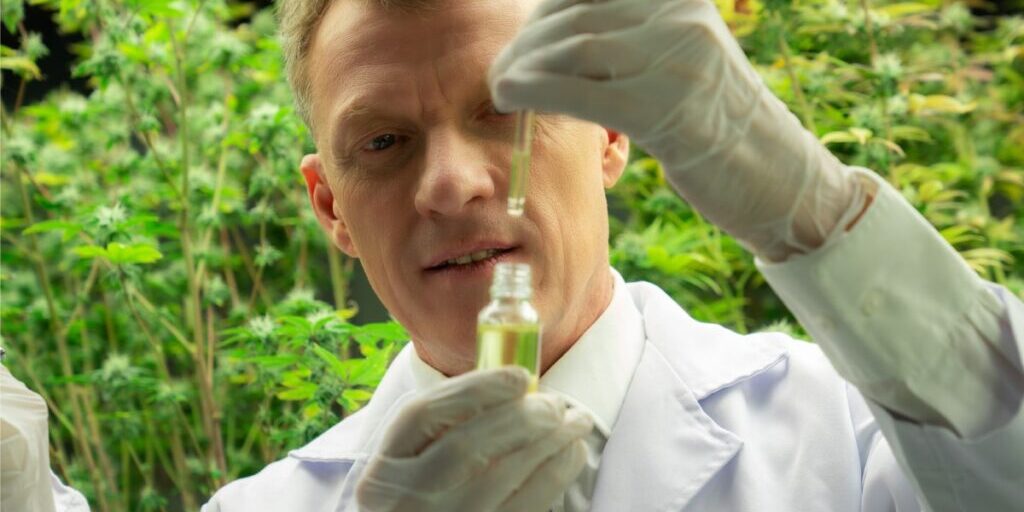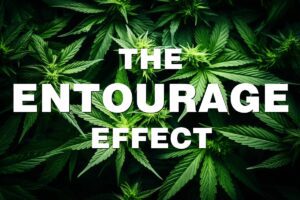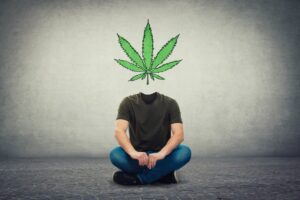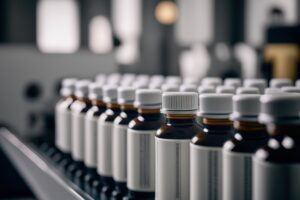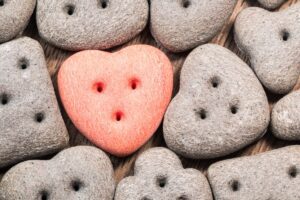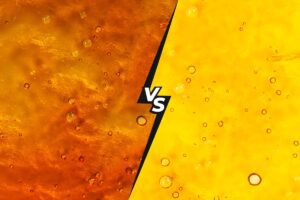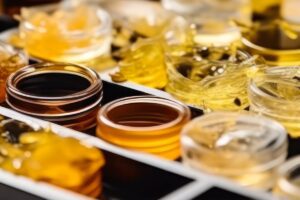Cannabidiol — called CBD for short — is the active ingredient derived from cannabis.
CBD is a truly versatile natural medicine. It comes in so many forms because it mixes well with just about everything, from extracts to oil tinctures to softgels, capsules, gummies, skincare, vapes, and more!
Let’s explore the most popular CBD products to answer the question, “What does CBD look like?”
What raw CBD extract looks like
Raw CBD extract is typically between 58% to 70% Cannabidiol. It has a thick, pastelike consistency at room temperature (68°F to 72°F).
Generally, raw CBD extract appears golden brown to rich mahogany in color. But extraction techniques substantially affect what raw CBD extract looks like. Some techniques leave behind chlorophyll and other plant matter that tint it dark green to brownish-black.
Crystallization occurs when raw CBD extract is left undisturbed for an extended period at anything below 65°F. Under these conditions, cannabinoid molecules in the extract arrange themselves into a lattice structure that may look like tiny, sparkling crystals when held up to the light.
Raw CBD extract is more likely to thicken and crystallize the more cannabinoids it has. How raw CBD extract looks depends on the rate of crystallization and the size of those CBD crystals. Smaller CBD crystals result in a smoother, creamier texture, while larger ones give raw extract a more granular feel.
Apply low heat (120 °F to 175 °F) to raw CBD extract to soften and melt it. Heating between 120 °F to 145 °F results in a viscous and tacky consistency akin to molasses. The hotter raw CBD extract becomes, the runnier it gets. Heating it to 175 °F or greater makes it easy to pour with a consistency of warmed maple syrup.
What CBD distillate looks like
CBD distillate potency ranges between 77% to 92% Cannabidiol. Its high CBD concentration means distillate rapidly crystallizes. Expect CBD distillate to look rock solid at room temperature (68°F to 72°F) if it has a potency higher than 80%. CBD distillate ranges from pale yellow to gold, amber, dark brown, or mahogany.
Distillation is a separation technique that produces a much more refined CBD extract. The process relies on the differences in boiling points of the phytochemicals in CBD.
Making CBD distillate involves heating the extract to vaporize volatile compounds. These are then separated from the purified final product. For example, CBD distillation removes remaining waxes, lipids, and other plant matter that some find undesirable. It’s also used to separate and remove the psychoactive cannabinoid THC. That’s how you can go from a full spectrum CBD distillate with THC to a broad spectrum CBD distillate with no THC.
CBD distillation produces a cleaner-looking extract that has more mass commercial appeal and costs less per gram. But there is a tradeoff. Distillation destroys some of the more fragile plant medicines that are thought to make CBD work better through a natural phenomenon called the entourage effect. CBD may lose some of its effectiveness as a result, even if at a marginal level.
Use low heat (140 °F to 175 °F) to soften and melt CBD distillate. The hotter it becomes, the runnier it gets. Heating CBD distillate to 175 °F or hotter makes it easy to pour with a consistency of runny syrup.
There’s one final purification technique that manufacturers use to change CBD distillate from a cannabinoid-rich extract to a single-molecule isolate. The process significantly changes what CBD looks like. Let’s explore how in the next section.
What does CBD isolate look like?
Believe it or not, the purest form of CBD — called an isolate — is colorless, flavorless, and odorless!
Pure CBD isolate looks like a white, granulated powder with tiny crystals similar to sugar or table salt that dissolve quickly when heated.
The purification technique used to make CBD isolate affects what it looks like:
Single-washed CBD isolate
Usually reaches a maximum 95% purity and may have a slight tan or greenish tint due to residual flavonoids and other phytochemicals.
Double-washed CBD isolate
The surefire way to bump up purity levels and make the highest potency CBD isolate imaginable. The extra filtration steps produce a pharmaceutical-grade CBD extract that’s over 99.7% pure and looks like a bright white crystalline powder.
Detractors say CBD isolates have lost all the beneficial phytochemicals needed for CBD to work its magic. Isolate proponents contend the active ingredient Cannabidiol is what makes CBD effective — plus, isolates are the only way to get a truly THC-free product.
CBD isolate melts when heated to between 140 °F to 175 °F. Heated isolate powder transforms from a white crystalline powder into a clear to pale yellow liquid with a viscosity similar to runny syrup.
What does CBD oil tincture look like?
CBD oil tinctures are generally light amber to a golden brown. But don’t be surprised if yours is clear, tan, olive, mahogany, greenish-black — even pink!
Extraction techniques, the type of CBD used, and the carrier oil it’s infused with have a major impact on what CBD oil tinctures look like. Combined, these key elements produce CBD tinctures that look lots of different ways. The exact color will depend on the proportion of each one in your CBD oil tincture.
Those aren’t the only things that can change the appearance of CBD, either. Product potency, temperature, the color bottle it’s in, the expiration date, and even how it’s been stored affect what a CBD tincture looks like.
Your CBD oil might look more opaque because it has lots of CBD extract. The oil itself could feel thicker because it’s been kept in a cold room. It may look significantly darker because it’s packaged into a brown bottle.
Expired CBD oil might look indistinguishable from fresh CBD oil if stored in a cool, dry place away from direct sunlight.
What CBD softgels look like
Softgels look small, oval-shaped, and translucent. These little hard-shelled pods hold a liquid CBD oil concentrate inside. The color of CBD softgels can make them look a little different depending on the brand you’re taking.
Some CBD softgels appear pale yellow, while others look dark golden brown. Granted, the type of CBD extract makes a difference in what CBD softgels look like. But so does whether the manufacturer uses an amber-colored outer gelatin shell to enhance the appearance of their softgels.
What CBD capsules look like
CBD capsules are oblong-shaped, with a slightly tapered cylindrical body and a rounded, dome-shaped end. The capsule is composed of two halves, a longer body and a shorter cap, which fit together to form a closed container.
Your CBD capsules may contain a white, crystalline powder resembling sugar or table salt called CBD isolate or a powdered, water-soluble full spectrum distillate that’s off-white to pale yellow.
What do CBD gummies look like?
CBD gummies come in many shapes, colors, and sizes, from the traditional gummy bear shape to gummy worms, slices that look like fruits, and plain sugar-coated cubes.
The recipe for CBD gummies usually calls for sugar, gelatin, corn syrup, citric acid, and artificial colors. Take note, the more ingredients there are in CBD gummies, the larger the variation in what they look like.
Fresh, premium-quality CBD gummies should be soft and pliable to the touch, with enough moisture content to bounce back into their original shape if you give them a gentle squeeze.
Some CBD gummies are coated with granulated or powdered sugar. These will have a gritty to smooth outer texture.
Gummy CBD candy dries out quickly, so make sure you store the container tightly closed whenever it’s not in use. Keep your CBD gummies away from direct sunlight and extreme temperature changes for best quality.
What topical CBD looks like
Topical CBD products come in many different forms that are used to target localized areas of the body. These products include balms, salves, muscle gels, creams, and CBD rubs. Each product offers its distinctive advantages, tailored for a particular purpose.
Beeswax and other waxes, along with oils such as coconut oil or shea butter, are the primary components of balms. You might notice your CBD balm has a glossy appearance. Its color may have a muted, natural tint that looks pale yellow, beige, tan, or olive green. CBD balms are smooth and creamy. They’re meant to soothe and nourish dry or chapped skin and can be applied to areas such as the lips, hands, and feet.
CBD salves are similar to balms but are meant for smaller target areas of the body to address specific skin concerns, such as minor cuts, scrapes, and burns. The color of CBD salve looks pale yellow, beige, or tan. Some salves may have a slightly green or brownish tint.
Relieving CBD muscle gel combines menthol and other sensory stimulants to promote recovery after strenuous physical activity. CBD muscle gel may look creamy white to pale yellow, beige, tan, brown, or slightly green. Blue-colored CBD muscle gels have been artificially dyed to signal the user that they are cooling, whereas pink or reddish ones are warming.
CBD creams offer an alternate approach to other topical products because they are meant to be applied to large areas of the body. Creams often contain numerous ingredients in addition to CBD, so what they look like can vary. CBD creams are typically white, pale yellow, beige, tan, or brown.
What a CBD vape looks like
CBD vapes look like small glass or plastic cylindrical tubes filled with a thick, viscous liquid. This CBD “vaping juice,” as it’s called in modern parlance, is typically made from high-concentration CBD extract dissolved into propylene glycol and vegetable glycerin. Both are generally recognized as safe but may exacerbate asthma symptoms and cause throat irritation or dry cough in frequent vapers.
The top end of a CBD vape cartridge features a plastic, wooden, glass, or metal tip with a hole that’s meant for air to be drawn in for inhalation. At the bottom end is a metal stopper that attaches to a battery-operated vape pen. CBD vape juice is flash heated by an atomizer in the vape pen to produce a vapor cloud you inhale.
The color of the juice inside a CBD vape depends on the extraction method and type of CBD used. CBD vapes vary from clear to light tan, golden brown, deep mahogany, or rich green.

KEY TAKEAWAY
Knowing which kind of CBD product you’re taking is the first step to finding out how it ought to look. The extraction method, the type of CBD, and the form it comes in affect what CBD looks like most. But product potency, added ingredients, how old it is, and even how CBD has been stored can change what it looks like. CBD is generally white, pale yellow, golden brown, or mahogany. It may also appear tinted green if it has chlorophyll.
What does CBD oil look like
So many different factors affect what CBD oil looks like that it’s important to consider them all.
Generally, CBD oils appear from light amber to a golden brown. But you shouldn’t be surprised if yours looks clear, olive, deep mahogany, greenish-black, or even pink.
Let’s explore the key elements and find out what really makes CBD oil tinctures the most visually diverse CBD product of the bunch.
How extraction methods affect what CBD oil looks like
You can divide CBD extract into three distinct types: full spectrum, broad spectrum, and isolate.
All three types of CBD begin their journey with a similar raw cannabis extract. But it’s the post-extraction process that gives each CBD type a unique look, taste, and aroma.
Full spectrum CBD oil
Full spectrum extract is the least processed type of CBD. It’s loaded with hundreds of plant medicines called phytochemicals — over 100 cannabinoids, terpenes, flavonoids, polyphenols, and more! Full spectrum CBD oil is usually full-flavored and rich in color.
What your CBD oil looks like is influenced by the natural pigments in cannabis called flavonoids. Full spectrum CBD oil has the most robust color expression of all the types of CBD. It can range from pale yellow to gold, amber, dark brown, mahogany, dark green, or greenish-black.
Broad spectrum CBD oil
Chromatography is a processing technique that separates THC — the psychoactive cannabinoid in cannabis — from the other non-psychoactive cannabinoids.
Broad spectrum CBD oil contains many of the same cannabinoids as its full spectrum counterpart. But the delicate terpenes and flavonoids are largely removed from broad spectrum CBD as a result of the THC filtration process.
The look of your broad spectrum CBD oil may appear lighter than full spectrum oil because it has fewer phytochemicals. As a result, broad spectrum CBD oil often looks pale yellow to gold, amber, dark brown, or mahogany.
CBD isolate oil
Radically purified CBD isolate powder, like the pharmaceutical grade isolate from Zero High® brand CBD, is so pure it’s colorless, flavorless, and odorless.
Isolate CBD powder is a single-molecule extract because it has no other detectable cannabinoids, terpenes, flavonoids, polyphenols, or other phytochemicals.
CBD oil made with ultra-purified isolate powder is the only real way to take CBD with no THC.
How carrier oils affect what CBD oil looks like
CBD extract — whether raw, distillate, or isolate — is a lipophilic molecule that needs an oil base to dissolve.
Carrier oils are the simplest way to dilute full-strength CBD extract into smaller doses. They’re called carrier oils because they “carry” the active ingredient Cannabidiol into your body.
What CBD oil looks like may vary significantly based on the carrier oil used. The most common carriers in CBD tinctures include MCT, hemp seed oil, olive oil, and grapeseed oil.
MCT oil
Medium-chain triglyceride (MCT) oil is the best carrier oil for CBD tinctures because it’s colorless, odorless, and flavorless. MCT allows for the natural color and taste profile of CBD to really shine through.
MCT-infused CBD oil could range from clear to pale yellow to deep mahogany based on the color of the extract and how much of it is used. Sometimes, MCT-oil-infused CBD might even turn a shade of pink!
Hemp seed oil & olive oil
CBD oil that looks a shade of clear light green to dark green is probably made with either hemp seed oil or olive oil. Both carrier oils contain chlorophyll, a green pigment that gives the leaves in plants their characteristic color. Chlorophyll will also tint your CBD oil tincture green.
Take note, if you add a rich brown or deep mahogany-colored CBD extract to the mix, it can result in a slightly muted, earthy tone that appears dark green to greenish-black. The exact shade of green will depend on the proportion of each color in your CBD oil tincture.
Grapeseed oil
Grapeseed oil is a relatively neutral-colored carrier oil used in CBD infusions. It’s most often a lighter shade of yellow but can range to a dark, more golden hue. Some grapeseed oils have a slightly greenish tint or a cloudy appearance. All of these could affect the look of CBD oil.
Other factors that affect what CBD oil looks like
Extracts and carrier oils aren’t the only things that affect how CBD looks. Potency, CBD oil temperature, bottle color, when it expires, and how it’s been stored are other factors that could change what CBD oil looks like.
CBD potency
How much CBD is in your oil tincture is a major factor that influences how it looks. High-potency CBD oils look darker and more opaque than low-potency formulas.
Temperature
CBD oil thickness can change due to a phenomenon called viscosity. At lower temperatures, oil molecules move slowly because they are packed closer together. Cold CBD oil will appear thicker and more viscous as a result. Conversely, higher temperatures cause the oil molecules to spread farther apart, making them move faster. That’s why warmer CBD oil has a thin and runny flow in comparison.
Container packaging color
CBD oil tinctures are usually bottled in amber glass bottles. Other common CBD bottle colors include clear, blue, green, and red. You’ll need to use a clear plastic or glass dropper to inspect the actual color of your CBD oil tincture.
Draw approximately 1 mL of CBD oil into the dropper and hold it to the light to check the color profile.
When CBD expires
What your CBD oil tincture looks like will change over time. The older it is, the darker CBD oil will become due to natural enzymatic processes and oxidation.
Always check the expiration date of your CBD oil whenever you open a new bottle so you know how long you have to consume it.
Learn how to spot if expired CBD oil is still good.
How it’s been stored
Where you store your CBD oil might visually impact its appearance. For example, CBD oil left in the direct sun accelerates natural breakdown processes that could substantially darken it. Extreme temperature fluctuations may do the same.
Make sure to keep your CBD oil in a cool, dry place. The ideal room temperature to store your CBD oil should hover around 70°F (21°C) and not exceed 77°F (25°C). Keep it away from direct heat sources like stoves and radiators. And do not expose your CBD oil to extreme temperatures (e.g., leaving it in a hot or freezing car).
Get tips to store CBD oil and extend its shelf life.

KEY TAKEAWAY
CBD oils typically appear from light amber to a golden brown. But yours might look clear, olive, deep mahogany, greenish-black, or even pink. Extraction techniques, the type of CBD used, and the carrier oil it’s infused with have a major effect on what CBD oil tinctures look like. But those aren’t the only things that can change the appearance of CBD. Product potency, temperature, the color bottle it’s in, the expiration date, and even how it’s been stored can add nuance to what a CBD tincture looks like.
How phytochemicals affect what CBD looks like
Phytochemicals are cannabis plant medicines that affect what CBD looks like in a significant way. Flavonoids, polyphenols, and — to a lesser extent — terpenes are naturally occurring phytochemicals that give CBD extract its characteristic color and appearance.
Flavonoids
Cannabis-derived flavonoids are yellowish pigments that influence the hues and shades in CBD extract. They are part of a class of phytochemicals called polyphenols susceptible to color changes caused by polyphenol oxidase (PPO).
This natural enzymatic process occurs when CBD is exposed to the elements. As a result, PPO will materially change CBD color as various compounds oxidize. Over time, it may potentially darken or brown the CBD product. The speed and intensity of the color changes are affected by factors such as exposure to light and heat.
Polyphenols
Polyphenols are a very diverse class of phytochemicals. They encompass flavonoids, including catechin and other tannins, cinnamic acid, caffeic acid, and ferulic acid. Like flavonoids, other polyphenols have characteristic colors that range from yellow to brown.
Terpenes
Terpenes are aromatic phytochemicals that interact with each other to affect what CBD tastes like. They may also interact with flavonoid and polyphenol color compounds to influence what CBD looks like. Terpenes are light yellow and only slightly affect CBD appearance.
Is it normal for CBD oil to change colors?
CBD is a natural product, so color changes over time are totally normal!
The color of CBD oil can vary from a golden brown color to deep mahogany or dark green. Sometimes, CBD oil can even turn pink if made with a coconut-derived carrier oil called MCT (medium-chain triglyceride).
Flavonoids and polyphenols are phytochemicals in your CBD oil that affect what it looks like. They are susceptible to a natural phenomenon called polyphenol oxidase (PPO). This enzymatic process is caused when CBD oil is exposed to air, sunlight, or temperature changes.
All CBD oil changes color as it ages. Keep yours looking its best — store CBD oil tightly closed when not using it, keep it out of direct sunlight, and protect it from extreme temperatures (e.g., avoid leaving it in a hot or freezing car). Refrigerating CBD will slow down but not stop PPO. Rest assured color changes do not affect the potency or purity of your CBD oil.

KEY TAKEAWAY
Phytochemicals affect what CBD looks like through a natural process called polyphenol oxidase (PPO). It’s an enzymatic reaction that could change the look of CBD extract and oil. The speed and intensity of CBD color changes are affected by exposure to light and heat. Changes to the color of your CBD oil are merely cosmetic and should not affect its potency and purity.
How can you tell if CBD oil is real?
CBD products are sometimes marketed without a clear distinction between CBD and hemp seed oils. They may also be made using substandard extracts or lower CBD doses than claimed on the label. In a world of fly-by-night operations and imposter products, how can you tell if CBD oil is real?
The first line of inspection should be the CBD product label itself. Legal over-the-counter CBD products manufactured in the USA must follow specific labeling guidelines. Check that your CBD product includes these important details on the product label:
- Hemp extract type and its source should be indicated with the total amount of CBD per serving
CBD oil extract should be made with the above-ground portions (aerial parts) of the cannabis hemp plant — not the hemp seeds - Maximum THC content should be listed below the federal legal limit for over-the-counter CBD oil
Only CBD oil that does not exceed 0.3% THC by volume is permitted in the USA for over counter use - QR code for a certificate of analysis (COA) should be prominently displayed and easy to scan with a smartphone
Avoid CBD oil products that do not have a scannable QR code for independent lab test results because they cannot be accurately verified
Below is an example label from Cannabiva 1,500MG Full Spectrum CBD Oil. The label clearly shows the source extract is hemp-based with at least 50 mg CBD per 1 mL serving size. In addition, it notes the maximum level of THC and provides a QR code that links to the product’s COA, where you can verify THC levels fall below the federal legal limit based on 3rd-party inspection.
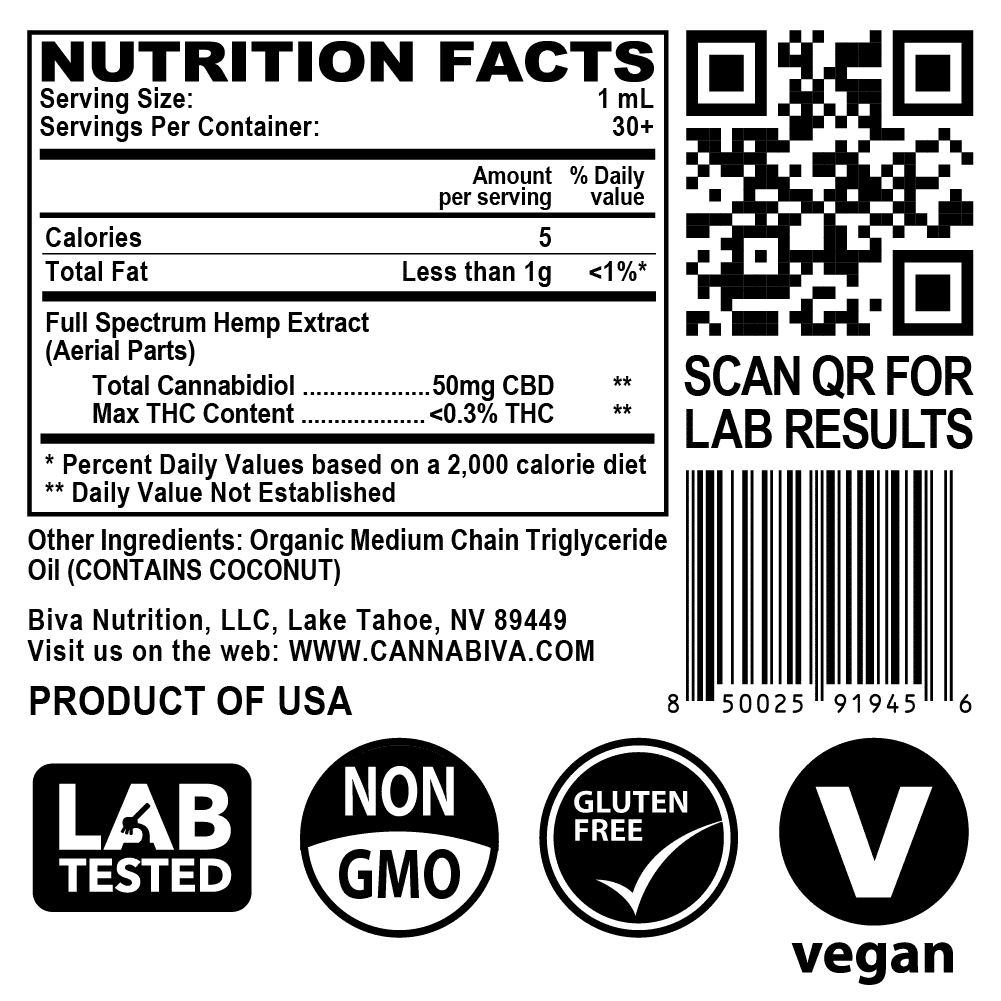
Genuine CBD oil should also display a ‘Use by’ or ‘Best before date’ printed on the product packaging. Can’t find an expiration date? Look for a lot number you could provide the manufacturer if you ever need to contact them about the product. Avoid CBD with no expiration date or lot number that can be tied to the product’s COA for verification. Products without them may not even be real CBD.
Organoleptic analysis is another simple way to tell if CBD oil is real. Don’t worry. You won’t need special tools or skills — just your eyes, nose, and tongue to make sensory observations of the color, odor, and taste of CBD oil. Real CBD oil can range from clear to pale yellow, amber, dark brown, rich mahogany, or deep green. CBD oil made from MCT may even turn a shade of pink.
Real CBD oil should also have a distinct cannabis aroma and taste profile. If you’re wondering, “What does CBD oil taste like,” look no further. Click the link for a comprehensive guide about CBD taste and smell.

KEY TAKEAWAY
Start by checking the product label to verify your CBD oil is real. CBD should be made from hemp leaves and flowers, not hemp seeds. Make sure the CBD contains less than 0.3% THC. Scan the QR code on the product label to review the independent Certificate of Analysis (COA) and to validate label claims against independent third-party analysis. Avoid CBD products that do not prominently display this information on their label because they cannot be adequately verified.
Summary
CBD can look a lot of different ways depending on the product.
While some people may prefer one form over another, it’s important to understand what affects the look of CBD so you can make an informed judgment. Recognizing the impact of each element on the visual and gustatory qualities of your CBD oil can help you find the right product for you.
There are key points to remember from today’s article about what does CBD look like:
- CBD can vary in color, texture, and consistency
- The natural medicines in CBD interact with the elements to affect what it looks like
- Ultimately, what CBD should look like depends on the form you purchase it in – each type has its unique characteristics
Ready to continue learning about CBD? We’re exploring what CBD oil tastes like in the next article.
Frequently Asked Questions About What CBD Looks Like
Check out the what does CBD look like FAQ if you don’t see your question answered in today’s article.
Chat with Cannabiva CBD Wellness Advisors if you still can’t find the answers you need. We’d love to help!





